(Photo by Patrick Gorski/Icon Sportswire)
Luis Severino is the bonafide ace of the New York Yankees pitching staff and one of the better starters in the league (we have him ranked number four overall). In his 21 starts, Severino has just five where his Game Score sat at 50 or lower (62 is his 2018 average). Of those sub-50 scores, three of them have taken place in July. None of the aforementioned starts saw Severino get the first out of the sixth inning.
Last night’s start against the Tampa Bay Rays (a team Severino has had great success against) didn’t provide the bounce-back opportunity many New York Yankees fans were expecting. Is this cause for concern over Severino going forward?
Let’s break down those three starts for a second and throw some numbers around. Severino was peppered for 25 hits while giving up 13 earned runs in 15 total innings (69 batters faced). Severino’s been knocked around before but its always several games apart. He’s given up just 12 home runs this year; half of them occurring in his last three starts amounting to a 3.6 HR/9. Prior to July, that metric never went higher than 1.8. He wasn’t wild; just three walks in 10 innings. May 13th, 19th, and 25th showed a hard-hit rate against Severino of at least 50%, while the month of June Severino was much stingier with contact. Against the Toronto Blue Jays (July 7th) and Cleveland Indians (July 12th), and last night against the Tampa Bay Rays, Severino was hit well; an average of 10% of his contract was considered ’soft’.
So has his repertoire been altered? Sort of, but I wouldn’t consider it the cause of his mediocre July performance.
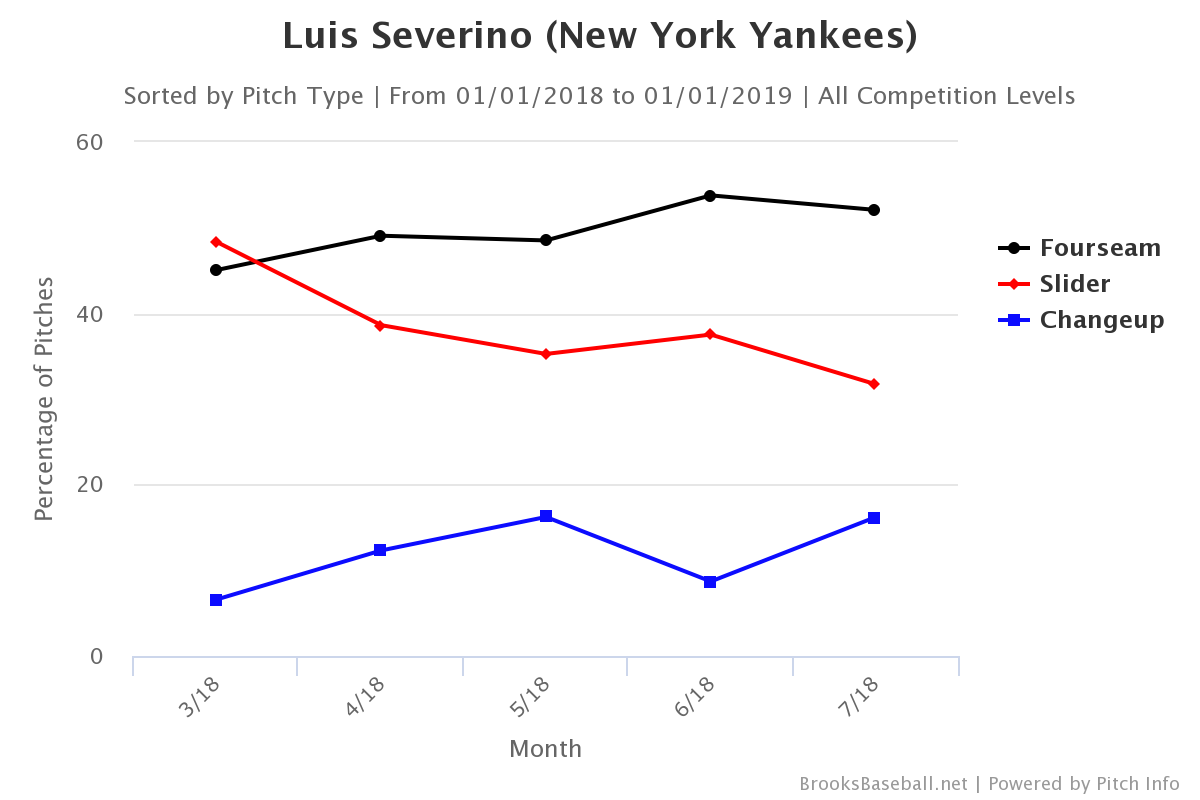
He’s been leaning on his four-seam fastball a bit more since May, apparently at the expense of his slider, while his changeup use is also trending up (somewhat inconsistently this season).
And how often are hitters going after those pitches? Below is Severino’s 2018 swing rate, showing more cuts at the fastball and change while hitters have started laying off the slider.
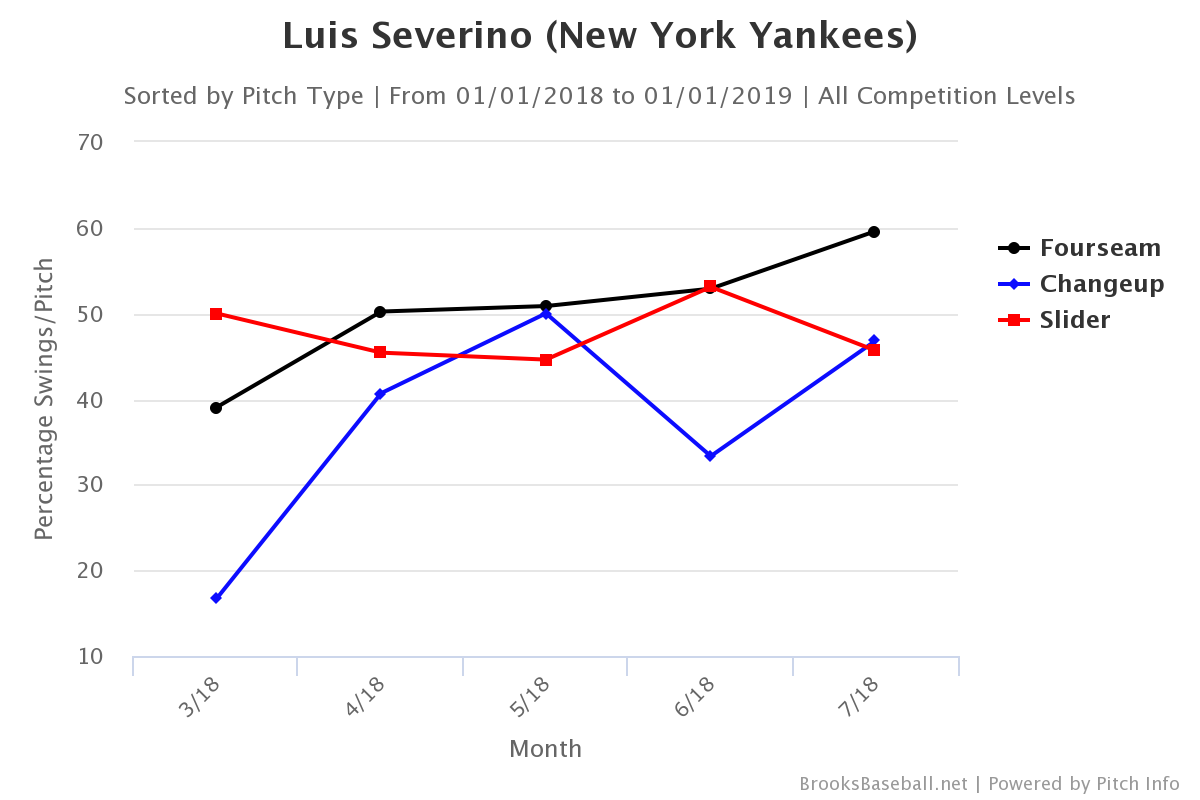
That’s interesting because four of the six home runs Severino has allowed are from throwing sliders. With this information, we could deduce that the slider is an issue suddenly. When he’s not missing the zone, he seems to be putting it on a platter for hitters.

OK, so his fastball isn’t doing well either; up nearly 100 points from his 3-month batting average against of .219. Looking at his slider, prior to July, Severino had about a .164 BAA. Now, its nearly doubled. Is one the result of the other? Maybe, but I believe we need to focus in on the slider; a quick assessment when trying to correlate the two pitches show that the slider is working independently of fastball success/failure.
Here is a pitch trail graphic showing one (out of six) of Severino’s home runs he’s allowed in July, courtesy of the Blue Jays’ Randal Grichuk hitting a 90 MPH slider.
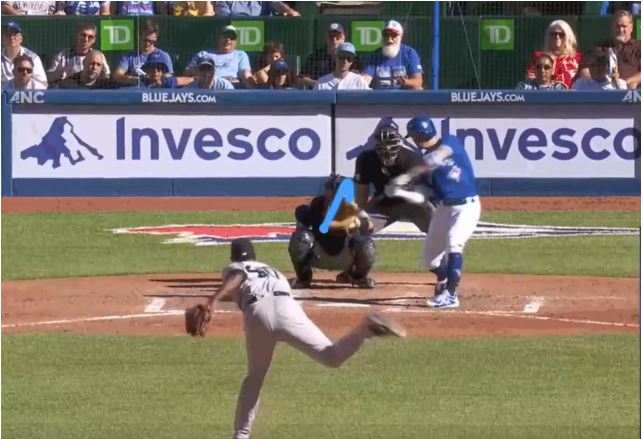
During that game in Toronto, all of Severino’s sliders to Grichuk were the same velocity, save for a few tenths of a mile per hour here and there. The difference between those and the home run? Spin axis. Severino’s rotation on his slider was several degrees different than the average of all the others he offered to Grichuk.
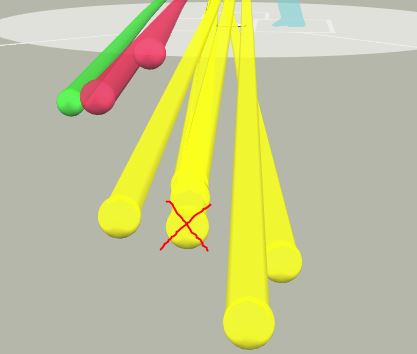
Severino threw four other sliders to Grichuk at nearly identical release points (red ‘x’ is HR pitch). You can see the others in that group breaking off horizontally to the left while the HR pitch stayed fairly steady and dropped down in the zone right into Grichuk’s wheelhouse.
Have a look at this HR he gifted Edwin Encarnacion. This one under good spin metrics (10″ horizontal, 38″ v+gravity break) but Severino just couldn’t have dropped the pitch in a worse spot.
[gfycat data_id=”ConcernedFoolishArawana”]
Getting back to last night at Tropicana Field, below is another slider given up for a home run which resulted in three of the six earned runs Severino was charged with.

Here are the release points of all the pitches Severino threw to Jake Bauers last night. The red ‘x’ is the pitch you see in the above screenshot.
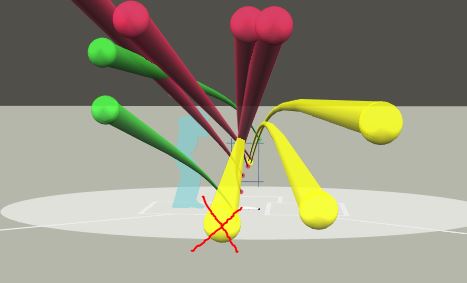
Despite the fact that Severino’s release point is all over the place, he still hung that slider with little horizontal movement which again could be due to a lesser spin axis.
That’s twice I’ve mentioned spin axis, huh? If you scanned over the article I linked when I first brought it up (which you should have), you’ll understand that with a slider, axis matters in the following context:
Ideally, a slider has a much more horizontal spin axis than a cutter/ 2-seam, which results in the Magnus force pointing more horizontal than vertical. This results in an increase in lateral break as well as vertical break due to the decrease in lift.
Sliders without a ‘functional’ spin axis aren’t going to be effective pitches. The horizontal break on both of the slider home runs was several inches less than his others that landed for strikes/balls/non-HR contact. Most of Severino’s sliders had displayed decent break, yet its the timing of that break that can make a difference. An early break is what can tip a hitter off; if its trajectory has changed prior to the commit point, the batter can make a more informed guess as to where the pitch is going. If the break is late, he’ll be fooled into swinging over or away from the pitch.
Let’s go back to the at-bat where Bauers the HR last night. Vertically, we aren’t seeing heavy movement. Its gradual and the trajectory will facilitate a good guess because the hitter can gauge where the pitch should arrive in the zone (yellow balls are recognition points, the purple are the commit points).

For horizontal movement, both sliders broke the same distance under two different release points. The first (yellow dot on the left) was taken for a strike. Later in the at-bat, Bauers saw the same thing albeit from a few inches difference. Both of the sliders had a similar spin axis and Bauer’s was able to capitalize.
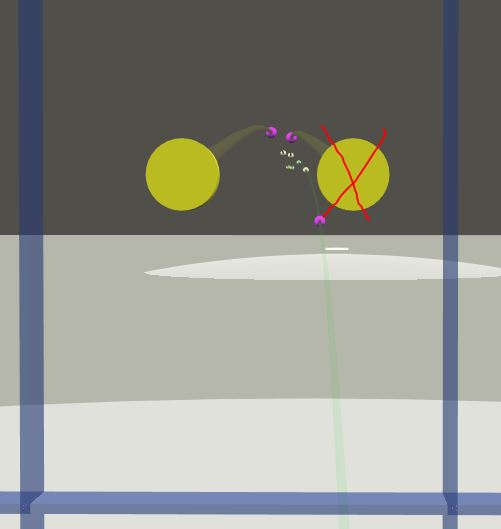
Take a look at how Severino should be delivering his slider.
[gfycat data_id=”HairyTidyAsiandamselfly”]
Both of the sliders in the gif show a vertical break of 32-plus inches (pretty standard for a Severino slider) but also have horizontal breaks of at least 9 inches. And that is where we are seeing a difference in efficacy. In the following gif, we have the HR slider to Bauers overlayed with a well-thrown ‘Severino-esque’ slider to Willie Adames.
[gfycat data_id=”UntriedSelfishDog”]
It may be hard for most to tell (camera angles weren’t ideal) so let me attempt to detail it a little more. The first shot of the overlay is the release point difference; the two-second pause in the above gif. Notice how Severino is letting go of the HR slider (top) earlier and higher.
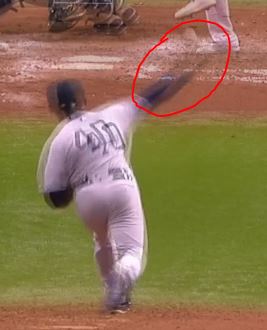
Then, one frame further, we see the difference in trajectory. The slider that lands for a strike (blue) is released slightly lower, under a much more useful spin axis creating strong horizontal and vertical break.
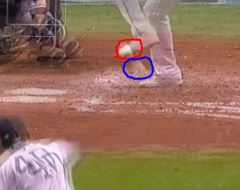
The HR pitch (red) had a decent vertical break but weak horizontal break. Both are necessary in tandem to generate swing and miss material.
Now, Severino’s apparent problems (with the slider in particular) aren’t without exceptions. The HR given up to Kevin Pillar earlier this month was under a great spin axis but Pillar just guessed right and got a great cut on the pitch. Those things are going to happen. However, those seemingly isolated mistakes are amplified when you’re not throwing your strongest pitch as well as you ought to. His walk rate is being maintained and the strikeouts are still there. Severino isn’t falling from grace and his performance in July is alarming (maybe a hidden injury?) but his stuff is too good to just fall off a cliff the way it appears to be in his last few starts.

Just wanted to say I thought this was an awesome piece of analysis. Cool to see the difference between the usual sharp Sevvy slider and the loopy one that the batters seem to have no problem tracking. I was hoping the longer rest over the ASB would get him back to untouchable mode. The guy is built like a bull but you wonder if fatigue or soreness/tightness of some sort is coming into play after he was showing decreased velocity in his start previous to this (97.3 mph on 7/12, back to 98.1 on 7/23). If nothing else it’s a reminder that 1) MLB hitters are good — they will punish mistakes; that’s why they are in the bigs, and 2) it doesn’t take much for a pitcher to go from untouchable to meh. Sevvy seemed to have also gotten away with a couple of bad loopy sliders left middle-middle in this last start. He has that luxury being able to pump 99 MPHs in there. But earlier in the year it makes you appreciate how he was ON and executing almost every single pitch; lately he’s just been off on a number of pitches each outing. As a Yanx/Sevvy fan you just hope he’s not executing due to sloppy mechanics and not some underlying issue because it’s clear to see he is still making a lot of guys look foolish.